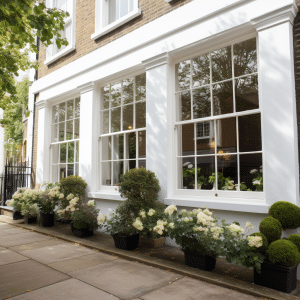Home / Knowledge Hub / The Timeless Charm of Sash Windows: A Journey Through History
The Timeless Charm of Sash Windows: A Journey Through History
Sash windows, with their classic elegance and practical design, have graced buildings for centuries. These windows, characterised by one or more movable panels or “sashes,” have a storied history that reflects the evolution of architecture, technology, and aesthetics. Explore the history of sash windows along with their development and enduring appeal.
History of Sash Windows: The Birth of a Classic Design
The precise origins of sash windows are somewhat shrouded in mystery, but their development is commonly attributed to the late 17th century. One popular theory credits English inventor Robert Hooke, known for his contributions to science and architecture. Hooke’s innovative designs were well ahead of their time, and the sash window was one of his many ingenious creations.
Sash windows first gained prominence in England during the late 1600s. The earliest known example can be found at Ham House in Surrey, dating back to 1670. The practicality of sash windows quickly caught on, and they became a staple in the grand Georgian and Victorian homes that dotted the English landscape.

Ham House, Richmond, Surrey, England
The Georgian Era: Elegance and Symmetry
The Georgian period (1714-1830) was a golden age for sash windows. During this time, architectural styles emphasised symmetry, proportion, and elegance. Sash windows, with their balanced and refined appearance, were a perfect fit for Georgian aesthetics.
Georgian sash windows typically featured six panes per sash, a design dictated by the limitations of glass production at the time. Large, single panes were difficult to manufacture, so multiple smaller panes were used instead. These windows not only allowed for ample natural light but also added to the architectural harmony of Georgian buildings.

The Victorian Era: Innovation and Expansion
The Victorian era (1837-1901) saw significant advancements in technology and manufacturing, which influenced the design and functionality of sash windows. Innovations in glass production allowed for larger panes, leading to the popular “two-over-two” configuration, where each sash contained two large panes of glass.
Victorian sash windows often featured intricate detailing and embellishments, reflecting the ornate tastes of the time. Bay windows, incorporating multiple sash windows, became a common feature in Victorian homes, adding depth and character to their facades.

Traditional houses in Notting Hill neighbourhood in London
The 20th Century: Challenges and Revival
The 20th century brought both challenges and revival for sash windows. The rise of modernist architecture, with its emphasis on clean lines and minimalism, led to a decline in the popularity of traditional sash windows. Additionally, the advent of new materials like aluminium and PVC provided alternatives that were often cheaper and easier to maintain.
However, the latter part of the 20th century saw a resurgence of interest in historical preservation and traditional craftsmanship. Homeowners and architects began to appreciate the timeless beauty and historical significance of sash windows. A growing market for period property restorations and a renewed interest in sustainable building practices fuelled this revival.

Facade of a Regency terraced house with white painted stucco in London, England
The Modern Era: Combining Tradition and Technology
Today, people continue to cherish sash windows for their aesthetic appeal and historical charm. Modern manufacturing techniques have made it possible to combine traditional designs with advanced materials and energy-efficient features. Contemporary sash windows often feature draught-proofing, and enhanced security measures. This ensures they meet the demands of modern living while retaining their classic look.
Architects and designers now celebrate sash windows as a symbol of timeless elegance, incorporating them into both period restorations and new builds. Their enduring appeal lies in their ability to blend seamlessly with various architectural styles.
The Legacy of Sash Windows
The history of sash windows is a testament to their enduring charm and versatility. Sash windows have remained a beloved feature in architecture. Their journey through history reflects broader trends in design, technology, and cultural values. This makes them a fascinating subject for anyone interested in the evolution of our built environment.
As we look to the future, it is clear that sash windows and their charm will continue to captivate and inspire, reminding us of the timeless beauty that lies in thoughtful design and craftsmanship. Whether you’re restoring a period property or simply appreciating the architectural gems of the past, the story of sash windows is one that continues to unfold, adding a touch of elegance to the narrative of our built heritage.
